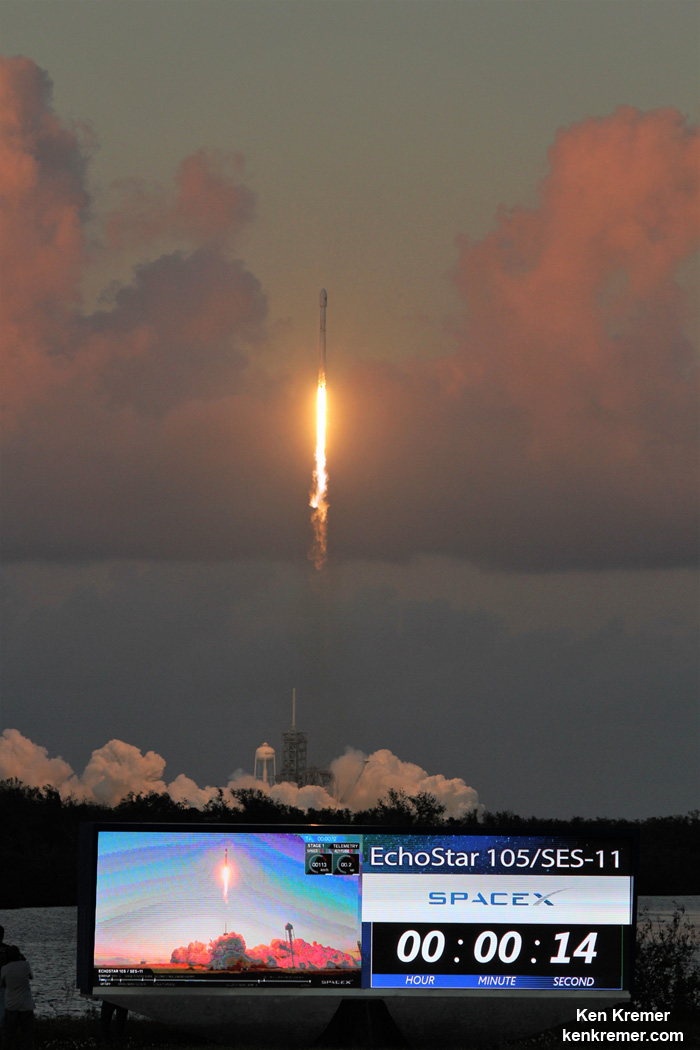
SpaceX Falcon 9 recycled rocket lifts off at sunset at 6:53 PM EDT on 11 Oct 2017 carrying SES-11/EchoStar 105 HDTV commercial comsat to geosynchronous transfer orbit from Launch Complex 39A at NASA's Kennedy Space Center, FL- as seen from the pad perimeter. Credit: Ken Kremer/Kenkremer.com
KENNEDY SPACE CENTER, FL - SpaceX staged a stunning sunset blastoff this evening Oct. 11, of the commercial SES-11/EchoStar 105 HD TV satellite that will serve the everyday needs of millions of customers across North America as it soared to orbit on a recycled Falcon 9 from the Florida Space Coast.
Minutes later the now doubly 'flight-proven' booster safely made its way back to Cape Canaveral after reigniting its engines to carry out another upright soft landing and recovery – that potentially sets the stage for a unprecedented third launch.
The private SES-11/EchoStar 105 communications satellite mission made an on time liftoff of the recycled first stage booster at dinnertime Wednesday Oct. 11 at 6:53 p.m. EDT from seaside Launch Complex 39A at NASA's Kennedy Space Center in Florida.
SpaceX successfully delivered the two and a half ton EchoStar 105/SES-11 joint mission satellite for SES and ExchoStar to geostationary transfer orbit some 22,000 miles (36,000 kilometers) above the equator.

Sunset blastoff of SpaceX Falcon 9 recycled rocket at 6:53 PM EDT on 11 Oct 2017 carrying SES-11/EchoStar 105 HD TV commercial comsat to geosynchronous transfer orbit from Launch Complex 39A at NASA's Kennedy Space Center, FL- as seen from the famous countdown clock. This launch counts as third reflight of a liquid fueled orbit class rocket. Credit: Ken Kremer/Kenkremer.com
EchoStar 105/SES-11 is a high-powered hybrid Ku and C-band communications satellite launching as a dual-mission satellite for US-based operator EchoStar and Luxembourg-based operator SES.
The used two stage 229-foot-tall (70-meter) Falcon 9 rocket was rolled out to pad 39A Tuesday to ready it for today's liftoff.
The EchoStar 105/SES-11 spacecraft was built by Airbus and shipped from the Airbus facilities in Toulouse, France to Cape Canaveral, FL for flight processing.
The satellite was successfully deployed as planned approximately 36 minutes after liftoff.
"SES-11 is a high-powered communications satellite designed to especially accelerate the development of the US video neighbourhood, and the delivery of HD and UHD channels. Optimised for digital television delivery, SES-11 joins SES-1 and SES-3 at the centre of its robust North American orbital arc, which reaches more than 100 million TV homes. Together with SES-1 and SES-3, SES-11 will be utilised for the expansion of the North America Ultra HD platform," according to SES.
"SES-11 offers comprehensive coverage over North America, including Hawaii, Mexico and the Caribbean, and will also empower businesses and governments to capture new opportunities and expand their reach across the region."
The 5,200 kg (11,500 pounds) satellite was encapsulated inside the payload fairing and integrated with the Falcon 9 rocket.
This is only the third recycled SpaceX Falcon 9 ever to be launched from Pad 39A.
SES was the first company to ever fly a payload on a 'flight-proven' Falcon 9. The SES-10 satellite lifted off successfully this spring on March 30, 2017.
The second reflown booster successfully launched the BulgariaSat-1 a few months later.
Pad 39A has been repurposed by SpaceX from its days as a NASA shuttle launch pad.
The last SpaceX Falcon 9 launch from KSC took place on Sep. 7 carrying the USAF X-37B military space plane to orbit just ahead of Hurricane Irma.
Watch for Ken's continuing onsite coverage of SpaceX SES-11, ULA NROL-52 and NASA and space mission reports direct from the Kennedy Space Center and Cape Canaveral Air Force Station, Florida.
Stay tuned here for Ken's continuing Earth and Planetary science and human spaceflight news.
Ken Kremer




















